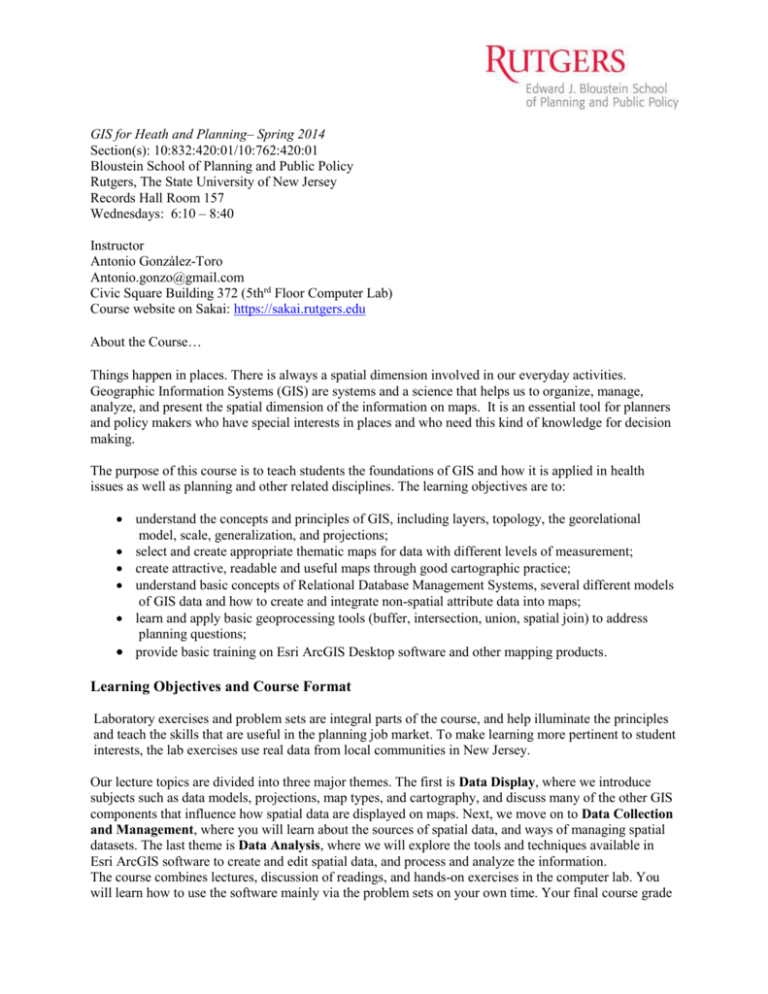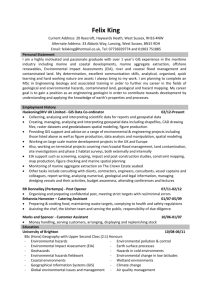420-SP14-Gonzalez-Toro-20131211-115632
advertisement

GIS for Heath and Planning– Spring 2014 Section(s): 10:832:420:01/10:762:420:01 Bloustein School of Planning and Public Policy Rutgers, The State University of New Jersey Records Hall Room 157 Wednesdays: 6:10 – 8:40 Instructor Antonio González-Toro Antonio.gonzo@gmail.com Civic Square Building 372 (5thrd Floor Computer Lab) Course website on Sakai: https://sakai.rutgers.edu About the Course… Things happen in places. There is always a spatial dimension involved in our everyday activities. Geographic Information Systems (GIS) are systems and a science that helps us to organize, manage, analyze, and present the spatial dimension of the information on maps. It is an essential tool for planners and policy makers who have special interests in places and who need this kind of knowledge for decision making. The purpose of this course is to teach students the foundations of GIS and how it is applied in health issues as well as planning and other related disciplines. The learning objectives are to: understand the concepts and principles of GIS, including layers, topology, the georelational model, scale, generalization, and projections; select and create appropriate thematic maps for data with different levels of measurement; create attractive, readable and useful maps through good cartographic practice; understand basic concepts of Relational Database Management Systems, several different models of GIS data and how to create and integrate non-spatial attribute data into maps; learn and apply basic geoprocessing tools (buffer, intersection, union, spatial join) to address planning questions; provide basic training on Esri ArcGIS Desktop software and other mapping products. Learning Objectives and Course Format Laboratory exercises and problem sets are integral parts of the course, and help illuminate the principles and teach the skills that are useful in the planning job market. To make learning more pertinent to student interests, the lab exercises use real data from local communities in New Jersey. Our lecture topics are divided into three major themes. The first is Data Display, where we introduce subjects such as data models, projections, map types, and cartography, and discuss many of the other GIS components that influence how spatial data are displayed on maps. Next, we move on to Data Collection and Management, where you will learn about the sources of spatial data, and ways of managing spatial datasets. The last theme is Data Analysis, where we will explore the tools and techniques available in Esri ArcGIS software to create and edit spatial data, and process and analyze the information. The course combines lectures, discussion of readings, and hands-on exercises in the computer lab. You will learn how to use the software mainly via the problem sets on your own time. Your final course grade GIS for Heath and Planning– Spring 2014 Wednesdays: 6:10-8:40 Professor: Antonio Gonzalez Toro will be based on your performance in three areas: the ten problem sets assigned throughout the course (50%), a midterm quiz (10%), the final project (30%), and your overall participation (10%). See below for details. Schedule Week Date 1 2 3 4 5 6 7 9 10 11 12 13 14 15 16 Lecture Topic Intro to Geographic Information Systems (GIS), definitions, components, brief history, and three core GIS concepts Basic mapping concepts, spatial representation, the nature of geographic data, generalization, and scale Intro to Esri, ArcGIS 10.2, and the ArcMap user interface Projections, coordinate systems, datums and projection tools in ArcGIS Thematic mapping, table joins, data classification, exploration and interpretation Land Use Classification and Basic Cartographic Principles More cartography, data visualization Geodata Discovery, applications and workflows 1/2 Geodata Discovery, applications and workflows 2/3 Intro to Spatial Analysis, Selections and Spatial Joins Geoprocessing and Spatial Analysis Address Geocoding On Line GIS Raster analysis in GIS, Spatial Analyst Extension GIS Policy and Future Technology Directions Final Presentations/Projects Assignment Due date - - Course Grading Problem Sets ---------Final Project ----------Mid-term Quiz -------Class Participation ---- 50% 30% 10% 10% (Scale: A=100-90, B+=90-85, B=85-80, C+=80-75, C=75-70, F=70-0) Sakai and the Online Classroom This course is designed to be paper-free, which means you should not ever print anything. We have an online classroom, called “Sakai,” where you will be able to access course materials, submit problem sets, ask questions, and post content anywhere you can connect to the Internet. The Sakai site is where you will receive grades and feedback, and communicate with your classmates and the course staff. We will go over each section of the Sakai site and its tools on the first day of class. To access Sakai, first go to http://www.sakai.rutgers.edu and log on using your Rutgers NetID and password. Academic Integrity Page 2 of 3 GIS for Heath and Planning– Spring 2014 Wednesdays: 6:10-8:40 Professor: Antonio Gonzalez Toro You are encouraged to work in groups on your problem sets. However, the written answers and maps that you turn in must be your own work. The final project must also be your own work and have proper citations. The Rutgers policies can be found at http://academicintegrity.rutgers.edu/academic-integrity-atrutgers. Textbooks Required readings can be downloaded on the Sakai site. J. Maantay & J. Ziegler. 2006. GIS for the Urban Environment.1 Kristen S. Kurland and Wilpen L. Gorr. 2012 GIS Tutorial for Health: Fourth Edition P. Longley, M. Goodchild, D. Maguire, D. Rhind. 2011. Geographic Information Systems and Science.2 C. Brewer, 2005. Designing Better Maps: A Guide for GIS Users.3 GIS Software and Data We will be using ArcGIS 10.2 for this course. The software is available in the computer labs on the 3rd and 5th floor of the Civic Square Building. It is also available in some of the other labs around campus, but not all. You will receive a complimentary 1-year license for ArcGIS 10.2 as part of our university site license. You will be able to use the license on your home computer. However, your home computer should be a Windows-based machine and have sufficient RAM (at least 2GB) and disk space for this program. All Data for the class will be made available via Sakai or on a shared cloud drive. 1. This is a very good introductory book of GIS for urban planning. The book is divided into 3 parts: (1) basic text (theory and concepts); (2) case studies; and (3) laboratory exercises with ArcGIS. 2. An excellent reference book for your library, as it covers the theory and concepts in more detail and with broader coverage than the Maantay and Ziegler text. Make sure that you purchase the Third Edition, as significant changes were made. 3. An excellent reference on basic cartography for GIS users. Page 3 of 3





